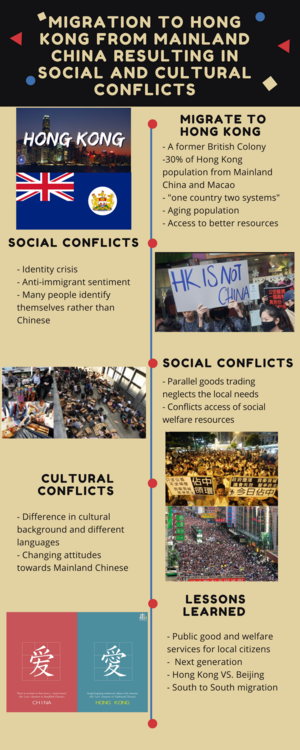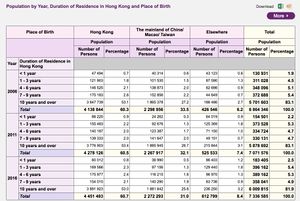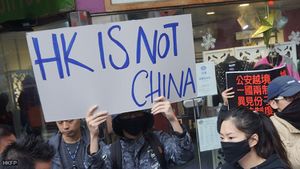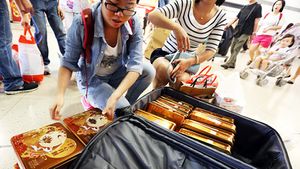Course:GEOG352/ Migration to Hong Kong from Mainland China resulting in social and cultural conflicts
| Hong Kong | |
|---|---|
| General Information | |
|
• Population:
• Area: 2,755 sq km (1,064 sq miles)[2] • Major Languages: English • Chinese[3] • Currency: HKD[4] | |
| Infographic | |
Migration to Global South
Due to the globalization and urbanization, the number of international and rural-to-urban migrations has grown rapidly in the last decade,becoming a global phenomenon. In the year of 2013, there were 232 million people living outside their country of birth or citizenship. Among all the types of migration, the south-to-south migration account for 36%, ranked as the most common type of migration1. Migration has brought advantages such as workforce growth, economic competitiveness, and infrastructure development to countries within the global south. It is important to note that the migrants within the global south are mainly low skilled workers and most countries in the global south are considered as developing nations due to the long colonial history. Since many labours, especially low-skilled workers, experience difficult time attaining an upper social status and accessing economic resources in their home countries because of low education level and fewer work opportunities, people who live in the global south would like to migrate to a metropolitan area or a mega-city in order to hunt for better life quality. In addition, low-skilled migrants cannot support themselves to migrate to a developed state due to the financial and political policy. Also, since most of the low-skilled workers are less educated, they may experience barriers such as language difficulties if they want to be international migrants. The intraregional migrations or migration to neighboring countries entail less distance, less cost, and share the minor cultural and language differences within the global south. This situation triggers the south-to-south migration becoming the best choice for the low-skilled workers because they can easily adapt to their new life. Thus, most of the migration cases in the global south are short distances, unlike the cases in the global north.
Overview: Migration and Mobility in Hong Kong
Hong Kong, one of the most advanced megacities in Global South, with the large influx of immigrants from different countries around the world. Hong Kong is a Special Administrative Region of the People's Republic of China, the Basic Laws ensure that the political situation will remain in effect for 50 years since 1997. Hong Kong as a former British Colony, there is a continuous migration from the Mainland China since 1997 due to reunification with China and results in rapid growth of population. According to the Summary Results of 2016 Population By-census, Hong Kong has a total population of 7,336,585 in which 60.7% of the population was born in Hong Kong, 31% are from Mainland China, Macao and Taiwan, and 8% from other places 2.
1949 is epoch-making times in Hong Kong’s immigration history because the immigrants from the Mainland poured into Hong Kong with the Civil War between the Kuomintang and the Communist Party. The implementation of the policy “one country, two systems” formulated in 1997, which brought several social and cultural conflicts between Mainland China and Hong Kong. Moreover, more and more Mainland Chinese have migrated to Hong Kong since 1949, which brings tremendous pressure on Hong Kong's society. However, Hong Kong was experiencing aging population, which influenced the local life practices. The Hong Kong immigration policy was trying to alleviate the problem of aging population. Hong Kong government more concerns about issues relevant to the quality of city's life, which means aging population may impact on the economic development and other influences in a certain degree. In order to reduce the aging population in Hong Kong, the government tries to “unleashing the potential of the local labour force nurturing local manpower, attracting talent from outside Hong Kong, fostering a supportive environment to form a family, and active aging.” [[ https://www.policyaddress.gov.hk/2016/eng/p163.html%7C3]]
Hong Kong is an important part of China and it shares similar culture history and life habits as the mainland. The bad poor air quality, water pollution and other environmental as well as food quality issues in Mainland China making obvious contrast compared with the social phenomenon in Hong Kong. The distance between Hong Kong and Mainland China is quite closed and the Chinese government encourages Mainland people to travel or work in Hong Kong. For low-skilled workers, they can cost less to migrate to China and experience better living surroundings. As well as self-employed can invest in Hong Kong, which benefits the business works earn more revenue. A free trade agreement is called CEPA, which encourages business investment in Hong Kong from Mainland China market [[ https://www.tid.gov.hk/english/cepa/index.html%7C4]]. Those financial program and policy ensure that low-skilled migrants can hunt for more work opportunities. Also, the social welfare and education system can make sure their offspring’s life quality. In order to provide their next generation better education environment and higher quality of life, most low-skilled migrants choose Hong Kong as the best place to migrate.
Moreover, the Hong Kong society is less collaborated than before due to the social tensions between the locals and the non-locals that the new immigrants are usually seen as the ‘Others’ and excluded from the society. Conflicts arise from the variations in cultural backgrounds, life practices, languages, and forth. Migrate from one city to another is a global phenomenon because anywhere with high-quality life and social welfare which include economic, education, transportation, medical service, etc. It will attract more people migrate and pull local citizens from the less favorable environment. The social and cultural conflicts among the locals and the Chinese immigrants in Hong Kong take bad impacts on everyday experiences.
Case study of Hong Kong
Social conflicts
No doubt that, Hong Kong is a part of China in political perspective. However, the differences in government policies and economic developments since British colonialism have constituted a totally different way of living in local and international level. The integration of Hong Kong government policy with the developments of mainland China is intimately connected with each other but neglects the daily necessary needs of Hong Kongers have deepened the tensions between the locals and the immigrants. This has tearing the Hong Kong society into the locals and the immigrants as the “Others” due to misunderstanding and prejudices.
While affording the irrational housing prices due to the influx of investors from China and the influx of mainlanders, Hong Kong people are struggling in accessing the social resources due to uneven distribution. The migration problem raises the issues of identity crisis that many Hong Kong people refuse to admit Hong Kong is a part of China or Chinese is their nationality. Some Hong Kong people even advocate separating Hong Kong from China, as an independent country. The University of Hong Kong conducted a survey on the ethnic identity of the local people through asking respondents “Who are you?” and there were only 14% of the respondents identify themselves as Chinese while 40% of them identify themselves as “Hongkongers” 5.
According to the Hong Kong Immigration Department, there were around 40,500 one-way permits delivered in 2014 for the Chinese immigrants due to family reunification and career development. In other words, Hong Kong is receiving 150 new incomers every day. The initial purposes of the one-way permits are assisting the mainlanders to marry to Hong Kong spouses, to alleviate the aging population, increase the labor pool. However, the majority of the mainland China immigrants who got the one-way permit are the low-skilled labor in which creating a great burden on social welfare including education, public health care services, public housing subsidy. More importantly, the immigrants who granted the permit to live in Hong Kong are the middle-age group that not really helpful in mitigating the aging problems.
Despite one-way permits, the changing economy and the purse for better food quality in mainland China have created the informal economy of bringing goods and products from Hong Kong and sell them in China. Due to the proximity to Shenzhen, there are more and more short-term visitors travel to Hong Kong everyday and conduct the parallel-goods trading wherever close to the mainland China border. The goods seized include food, skin-care products, electronic products, milk powder, medicine, and forth due to Hong Kong has a higher food security. Since the parallel-goods trading is not illegal in Hong Kong and the vulnerabilities in immigration law, some new incomers would rather earn money from the parallel good trading. The parallel good trading boosts the growth of drug store and competes with the local needs such as the milk powder was purchased by the traders which boosted the prices of the milk powder. As Lee argued that “Traders have been accused of clogging up the MTR network, hogging daily necessities and fundamentally altering the retail landscape of large parts of Hong Kong, with traditional stores priced out by those catering to the needs of the traders” 6. These are all creating the social conflicts between the locals and the Chinese immigrants, harming the social cohesion of the community. Hong Kong people may perceive the mainland Chinese immigrants as a threat in accessing the social and economic resources, which trigger a high level of anti-immigrant sentiment towards mainland Chinese immigrants.
Cultural conflicts
With the long colonial history, the different political system and cultural background increase the cultural conflicts between the China mainland migrants and Hong Kong locals as well. Since 1997, Britain was forced to abandon its control of Hong Kong and Hong Kong has been regulated by China again [[ http://finance.sina.com.cn/leadership/20120227/071611458348.shtml%7C7]]. In order to promote the harmonious relationship between the Hong Kong and the mainland, Chinese government encouraged mainland tourists to travel in Hong Kong and promoted mainland private companies have friendly cooperation with Hong Kong companies. According to statistics from the Hong Kong Tourism Administration, more than 27 million mainland tourists traveled to Hong Kong in 2012 [[ http://finance.sina.com.cn/leadership/20120227/071611458348.shtml%7C8]], which was three times the local population and rose by 16.5% from the previous year. This situation increased the demand for low-skill workers who can work in the house, factory line, and restaurants with low salaries. In addition, low-skill workers would like to migrate to Hong Kong because they thought this city is advanced and can provide a huge number of opportunities for them.
With the poor education, the bad influences and effects that made by some of Mainland travelers and low-skilled migrants took deep bad impacts on the Hong Kong people’s attitudes towards the mainland migrants. In spite of having many common cultural traditions, Hong Kong people have some common bias that mainland people lack a gentle temperament and public etiquette [[ http://finance.sina.com.cn/leadership/20120227/071611458348.shtml%7C9]]. Due to this condition, the cultural conflicts between the mainland migrants and the locals become stronger. The huge growth of low-skilled migration influenced and shaped the locals’ everyday experience and shocked the local economy. In addition, the huge amount of mainlanders traveled and worked in Hong Kong, seizing scarce resources such as employment, population mobility, housing prices, and social and medical benefits. Hong Kong citizens, especially lower class people, started to worry about their social welfare and be scared of losing opportunities.
Hong Kong is an important part of China, and it cannot be apart from China. This statement is easy to found in Chinese political textbooks. Plus, this statement took a very strong root in most low-skilled migrants. However, because of long colonial history, Hong Kong experienced an identity crisis, the sense of belonging towards China is quite low 10 and majority identify themselves as “ Hongkongers”[[ https://www-sciencedirect-com.ezproxy.library.ubc.ca/science/article/pii/S0147176798000340%7C11]]. The contrast with different attitudes towards the sense of belonging triggers the cultural gap between the low-skilled migrants and Hong Kong people. Sometimes, many low-skilled migrants think they cannot fit into society successfully. Also, because of “one country, two policies”, Hong Kong government has many Parties for people to follow and support, which is totally different from the political structure in the mainland of China. Because of the strong sense of belonging towards China, most low-skilled migrants would like to support the parties which advocated the mainland. However, due to an identity crisis in Hong Kong, those parties are not majority group and they only can provide a little help for low-skilled migrants.
The differences in lifestyle, cultural background, languages increase antagonism to Chinese immigrants. Hong Kong citizens regard themselves as “ Hongkongers”, contrarily, the compulsory education in mainland let the mainlanders strongly agree that Hong Kong is an important part of China and this part cannot be apart. The gap between the national identity and working resources increase the conflict between the Chinese low-skilled immigrants and Hong Kong locals.
Lessons Learned
Migration often brings poverty and informality to the urban context. Specifically, the massive migration has induced an increased competition in the labor market or even housing facilities or social welfare failing in Hong Kong. Also, the main consumers of the public goods and the welfare services are still mainly worked for the local citizens rather than the low-skilled migrants from the Mainland China. Apart from the drawbacks of migration that we mentioned above, it also has some bright sides. Migration has not only lead to the demographic changes in Hong Kong but also attract investments from Mainland China. This has boosted the economy in Hong Kong. Therefore, the migration from Mainland China to Hong Kong can be regarded as a two-sided event.
Similarly, it is controversial to say that migrating to Hong Kong is a good choice for the low-skilled-migrants. Although their children may get the chance of receiving the same welfare services and better education as Hong Kong citizens, their migrated life may not be as good as they imagined. At the same time when they get better job opportunities, they also may experience the drawbacks from the increased competition in the local market. For example, the increased competition may lead to higher price levels, and the cost of living in Hong Kong is significantly higher than its counterpart in Mainland China. From NUMBEO12, world’s largest database of the information about the living conditions of different cities, the consumer prices in Hong Kong are 70.6% higher than in Beijing. Also, the rent prices are 138.2% higher in Hong Kong than that in Beijing. Thus, at the same time of the migrated workers get higher wages, their cost of living also increased in Hong Kong. Thus, it is also uncertain to say that the quality of lives for the migrated workers have been improved.
In brief, migration has brought benefits as well as drawbacks for both Hong Kong citizens and the migrants from Mainland China. Whether it is a good thing or not could be subjective to different people, but we cannot ignore that south-to-south migration is a processing structure, not an event in the global world.
References
Reference List
- ↑ Population Estimates(2018, April 6). Retrieved April 6, 2018, from https://www.censtatd.gov.hk/hkstat/sub/so150.jsp
- ↑ Hong Kong Yearbook. Retrieved April 6, 2018, from https://www.yearbook.gov.hk/2016/en/index.html
- ↑ Hong Kong Yearbook. Retrieved April 6, 2018, from https://www.yearbook.gov.hk/2016/en/index.html
- ↑ Hong Kong Yearbook. Retrieved April 6, 2018, from https://www.yearbook.gov.hk/2016/en/index.html
1. Martin, P. (2013). "The global challenge of managing migration", Population Bulletin, vol. 68, no. 2, pp. 2.
2. Main Tables. Retrieved March 28, 2018, from https://www.bycensus2016.gov.hk/en/bc-mt.html
3.Policy Address: Responding to Population Ageing. Retrieved March 31, 2018, from https://www.policyaddress.gov.hk/2016/eng/p163.html
4.Main Content. Retrieved April 5, 2018, from https://www.tid.gov.hk/english/cepa/index.html
5. Chow, V. (2018). Changing Hong Kong people’s traditions won’t make them love China. South China Morning Post. Available at http://www.scmp.com/comment/insight-opinion/article/2133173/changing-hong-kong-peoples-traditions-wont-make-them-love [Accessed 15 February 2018]
6.Lee, D. (2015). More Arrests as Hong Kong continues crackdown on parallel goods trading, South China Morning Post. Available at http://www.scmp.com/news/hong-kong/article/1718013/more-arrests-immigration-officials-crack-down-parallel-goods-trading [Accessed 15 February 2018]
7. "香港的焦虑:两地消费文化冲突背后". (2012). Finance.Sina.Com.Cn. http://finance.sina.com.cn/leadership/20120227/071611458348.shtml.
8. Main Tables. Retrieved March 28, 2018, from https://www.bycensus2016.gov.hk/en/bc-mt.html
9."香港的焦虑:两地消费文化冲突背后". (2012). Finance.Sina.Com.Cn. http://finance.sina.com.cn/leadership/20120227/071611458348.shtml.
10. Chow, V. (2018). Changing Hong Kong people’s traditions won’t make them love China. South China Morning Post. Available at http://www.scmp.com/comment/insight-opinion/article/2133173/changing-hong-kong-peoples-traditions-wont-make-them-love [Accessed 15 February 2018]
11.Brewer, M.B. (19990, "Multiple identities and identity transition: implications for hong kong", International Journal of Intercultural Relations, vol. 23, no. 2, pp. 187-197. Available at https://www-sciencedirect-com.ezproxy.library.ubc.ca/science/article/pii/S0147176798000340 [Accessed 15 February 2018]
12.Living, C. (2018). Cost of Living. [online] Numbeo.com. Available at: https://www.numbeo.com/cost-of-living/ [Accessed 6 Apr. 2018].
| This urbanization resource was created by Course:GEOG352. |








